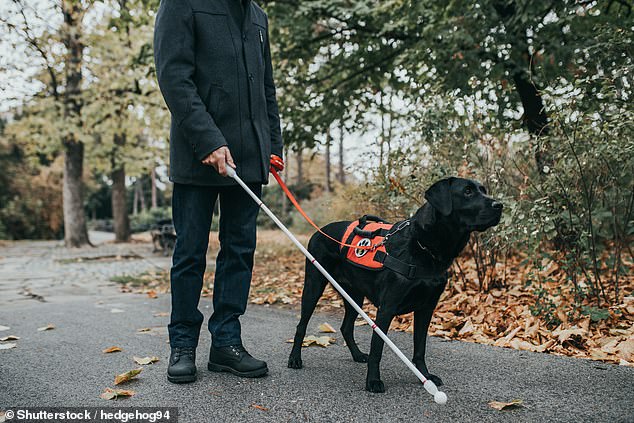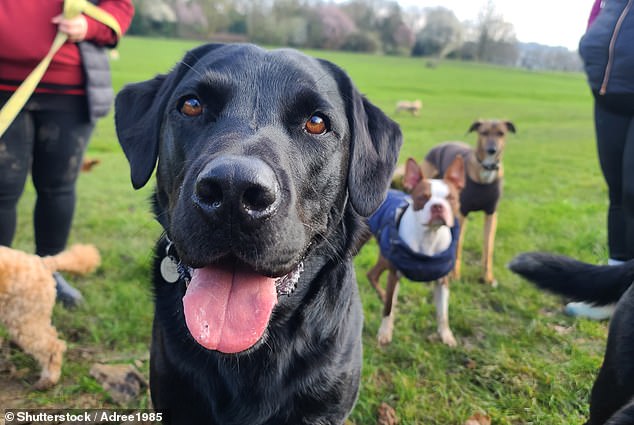Scientists discover that dogs are entering a new phase of evolution
Dogs could be undergoing a third wave of domestication, driven by people’s desire for pets that are friendly, calm and well suited to a sedentary lifestyle.
Just decades ago, canines were seen as working animals, tasked with hunting vermin, herding livestock and guarding their homes.
But nowadays, companionship is a much higher priority for pet owners.
Scientists have found that this shift has increased levels of a hormone responsible for social bonding in dogs, and especially service dogs.
As our lives have become more sedentary, so have the lives of our pets. Experts say our comfortable modern lifestyles are causing a third wave of dog domestication
A study concluded that the hormone oxytocin drives dogs to contact their owners.
As humans have domesticated wolves into the affectionate pets we know today, canines’ sensitivity to oxytocin has increased, according to the researchers.
The study, conducted by researchers at Sweden’s Linköping University in 2017, examined how dogs developed their unique ability to cooperate with humans, including their willingness to ‘ask for help’ when faced with a difficult problem.
The researchers suspected that the hormone oxytocin was involved because it is known to play a role in social relationships between individuals.
The effect of oxytocin depends on how well it binds to the receptor in the cells.
Previous studies have shown that variations in genetic material close to the gene that codes for oxytocin receptors affects dogs’ ability to communicate.
In other words, a dog’s social skills are partly ingrained in his genetics, specifically in the genes that control his sensitivity to oxytocin.
The researchers observed 60 golden retrievers as they attempted to lift a lid on a jar of treats, which was deliberately made impossible to open.
They also collected DNA swabs from the dogs’ noses to determine which variant of the oxytocin receptor each dog had.

A 2017 study found that service dogs have higher levels of oxytocin – a hormone that facilitates social bonding – than dogs
The dogs performed this behavioral test twice, once after receiving a dose of oxytocin nasal spray, and once after receiving a dose of neutral saline nasal spray.
The team timed the dogs to see how long they would try to open the jar on their own before turning to their owner for help.
The results showed that dogs with a particular genetic variant of the receptor responded more strongly to the oxytocin spray than other dogs, and that the dose of oxytocin made them more likely to ask for help than the dose of saline.
These findings provide insight into how domestication has changed the genes that influence dogs’ social skills.
Now dog experts Brian Hare and Vanessa Woods say dogs’ behavioral traits are undergoing a third wave of domestication.
As the role these animals play in our lives has shifted from worker to companion, so has their behavior, and perhaps their biology as well.
Hare is a professor of evolutionary anthropology at Duke University and director of the Duke Canine Cognition Center. Woods manages the center’s Puppy Kindergarten program, which trains puppies to become service dogs.
The Puppy Kindergarten also serves as a long-term research project to assess how different training strategies affect the behavior and cognitive development of dogs.
Studying these puppies convinced Woods and Hare that service dogs are “uniquely well adapted to life in the 21st century,” they wrote in The Atlantic Ocean.
These dogs are ‘highly trained professionals’ who can assist their owners with tasks, remain calm and quiet when not actively working, and have a uniquely friendly nature.
“Unlike most dogs, service dogs are attracted to strangers, even as puppies,” Woods and Hare wrote.
“And increasing friendliness appears to have changed the biology of these dogs, just as it did thousands of years ago,” the researchers added.
These highly trained dogs embody the qualities of the ideal canine companion. They fit seamlessly into the lives of their owners and into the modern world.
“Service dogs fit into their lives in a way that many able-bodied dog owners want their pets to fit into theirs,” Woods and Hare wrote.
Just a few decades ago, dogs were viewed very differently than they are today. They were work animals charged with tasks such as hunting, herding, and guarding their home and the people in it – conditioned to be active and alert.
Until the 1990s, dogs spent most of their lives outdoors. Without the sprawling urbanization we see today, they had plenty of space to roam and explore.
“If your dog were to sleep on your bed, you would probably wake up covered in ticks or fleas,” the researchers wrote.

Some behaviors that made dogs attractive to our ancestors become maladaptive, such as protecting against strange people and animals
But nowadays more and more dogs live in densely populated areas, and therefore spend much more time indoors. They also have more contact with unknown dogs and people.
This shift led to behavior that made dogs attractive to our ancestors becoming maladaptive, Woods and Hare wrote. ‘For example, protection against strange people and animals can make it more difficult for a dog to walk through the neighborhood.’
“Dogs that are more energetic, irritable, fearful or anxious than average are more likely to be relinquished to shelters, where they may have difficulty finding new homes,” she added.
Woods and Hare believe that these new societal pressures are driving a third wave of dog domestication, with service dogs representing the most evolved members of the pack.
“Service dogs may look like your average Labrador retriever, but compared to military working dogs or even the average family lab, they are almost a different breed,” the researchers wrote.
“The differences between Canine Companion Dogs and House Dogs also show how different a dog population can be in less than 50 years,” she added.
The domestication of dogs dates back between 40,000 and 14,000 years. The first wave of domestication began when people lived as gatherers, often leaving food waste on the outskirts of their settlements.
Wolves that took advantage of this predictable, energy-rich food source gained a survival advantage, Woods and Hare say. ‘As a result, the attraction of animals to humans has replaced fear and aggression for generations.’
The second wave started after the industrial revolution. During this time, the emerging middle class wanted dogs that represented their owners’ good taste and disposable income.
This prompted Westerners to begin breeding dogs for specific physical traits, eventually creating most of the 200 dog breeds recognized today by the American Kennel Club, the researchers wrote.
As we enter a third wave of domestication – one more focused on tailoring dogs’ personalities to our modern world – Woods and Hare believe that humans must play an active role in facilitating this process.
“For the happiness of dogs and their owners, people must breed and train more dogs as service animals, and initiate a new wave of dog domestication to help them fit into the new world we have created,” they wrote.
